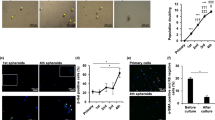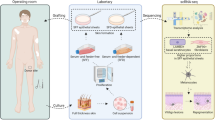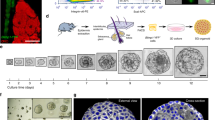Abstract
Gene therapy vectors are mostly studied in cultured cells, rodents, and sometimes in non-human primates, but it is useful to test them in human tissue prior to clinical trials. In this study, we investigated the possibility of using human sweat glands as a model for testing cystic fibrosis (CF) gene therapy vectors. Human sweat glands are relatively easy to obtain from skin biopsy, and can be tested for CFTR function. Using patients' sweat glands could provide a safe model to study the efficacy of CF gene therapy. As the first step to explore using sweat glands as a model for CF gene therapy, we examined various ex vivo gene delivery methods for a helper-dependent adenovirus (HD-Ad) vector. Gene delivery to sweat glands in skin organ culture was studied by topical application, intradermal injection or submerged culture. We found that transduction efficiency can be enhanced by pretreating isolated sweat glands with dispase, which suggests that the basement membrane is a critical barrier to gene delivery by adenoviral vectors. Using this approach, we showed that Cftr could be efficiently delivered to and expressed by the epithelial cells of sweat glands with our helper-dependent adenoviral vector containing cytokeratin 18 regulatory elements. Based on this study we propose that sweat glands might be used as an alternative model to study CF gene therapy in humans.
This is a preview of subscription content, access via your institution
Access options
Subscribe to this journal
Receive 12 print issues and online access
$259.00 per year
only $21.58 per issue
Buy this article
- Purchase on Springer Link
- Instant access to full article PDF
Prices may be subject to local taxes which are calculated during checkout







Similar content being viewed by others
References
Quinton PM . Physiological basis of cystic fibrosis: a historical perspective. Physiol Rev 1999; 79: S3–S22.
Sheppard DN, Welsh MJ . Structure and function of the CFTR chloride channel. Physiol Rev 1999; 79: S23–S45.
Boucher RC . An overview of the pathogenesis of cystic fibrosis lung disease. Adv Drug Deliv Rev 2002; 54: 1359–1371.
Gibson RL, Burns JL, Ramsey BW . Pathophysiology and management of pulmonary infections in cystic fibrosis. Am J Respir Crit Care Med 2003; 168: 918–951.
Dorin JR et al. A demonstration using mouse models that successful gene therapy for cystic fibrosis requires only partial gene correction. Gene Therapy 1996; 3: 797–801.
Kerem B, Kerem E . The molecular basis for disease variability in cystic fibrosis. Eur J Hum Genet 1996; 4: 65–73.
Amaral MD . Processing of CFTR: Traversing the cellular maze – how much CFTR needs to go through to avoid cystic fibrosis? Pediatr Pulmonol 2005; 39: 479–491.
Albelda SM, Wiewrodt R, Zuckerman JB . Gene therapy for lung disease: hype or hope? Ann Intern Med 2000; 132: 649–660.
Grubb BR, Boucher RC . Pathophysiology of gene-targeted mouse models for cystic fibrosis. Physiol Rev 1999; 79: S193–S214.
Koehler DR et al. Protection of Cftr knockout mice from acute lung infection by a helper-dependent adenoviral vector expressing Cftr in airway epithelia. Proc Natl Acad Sci USA 2003; 100: 15364–15369.
Limberis M, Anson DS, Fuller M, Parsons DW . Recovery of airway cystic fibrosis transmembrane conductance regulator function in mice with cystic fibrosis after single-dose lentivirus-mediated gene transfer. Hum Gene Ther 2002; 13: 1961–1970.
Grubb BR et al. Inefficient gene transfer by adenovirus vector to cystic fibrosis airway epithelia of mice and humans. Nature 1994; 371: 802–806.
Quinton PM . The sweat gland. In: Yankaskas JR, Knowles MR (eds). Cystic Fibrosis in Adults. Lippincott-Raven: Philadelphia, 1999, pp 419–437.
Quinton PM, Reddy MM . Control of CFTR chloride conductance by ATP levels through non-hydrolytic binding. Nature 1992; 360: 79–81.
Reddy MM, Quinton PM . Control of dynamic CFTR selectivity by glutamate and ATP in epithelial cells. Nature 2003; 423: 756–760.
Sato K, Sato F . Methods for studying eccrine sweat gland function in vivo and in vitro. Methods Enzymol 1990; 192: 583–599.
Palmer D, Ng P . Improved system for helper-dependent adenoviral vector production. Mol Ther 2003; 8: 846–852.
Lee CM, Jones CJ, Kealey T . Biochemical and ultrastructural studies of human eccrine sweat glands isolated by shearing and maintained for seven days. J Cell Sci 1984; 72: 259–274.
Sato F, Sato K . cAMP-dependent Cl(−) channel protein (CFTR) and its mRNA are expressed in the secretory portion of human eccrine sweat gland. J Histochem Cytochem 2000; 48: 345–354.
Kartner N et al. Mislocalization of delta F508 CFTR in cystic fibrosis sweat gland. Nat Genet 1992; 1: 321–327.
Kalluri R . Basement membranes: structure, assembly and role in tumour angiogenesis. Nat Rev Cancer 2003; 3: 422–433.
Toietta G et al. Reduced inflammation and improved airway expression using helper-dependent adenoviral vectors with a K18 promoter. Mol Ther 2003; 7: 649–658.
Chow YH et al. Targeting transgene expression to airway epithelia and submucosal glands, prominent sites of human CFTR expression. Mol Ther 2000; 2: 359–367.
Kozaki M et al. Immunohistochemical analysis of cytokeratin expression in dog skin. J Vet Med Sci 2001; 63: 1–4.
Watanabe S, Hirose M, Sato S, Takahashi H . Immunohistochemical analysis of cytokeratin expression in eccrine spiradenoma: similarities to the transitional portions between secretory segments and coiled ducts of eccrine glands. Br J Dermatol 1994; 131: 799–807.
Claass A et al. Applicability of different antibodies for immunohistochemical localization of CFTR in sweat glands from healthy controls and from patients with cystic fibrosis. J Histochem Cytochem 2000; 48: 831–837.
Bradbury NA . Intracellular CFTR: localization and function. Physiol Rev 1999; 79: S175–S191.
Hengge UR, Mirmohammadsadegh A . Adeno-associated virus expresses transgenes in hair follicles and epidermis. Mol Ther 2000; 2: 188–194.
Ghazizadeh S, Taichman LB . Virus-mediated gene transfer for cutaneous gene therapy. Hum Gene Ther 2000; 11: 2247–2251.
Li L, Hoffman RM . The feasibility of targeted selective gene therapy of the hair follicle. Nat Med 1995; 1: 705–706.
Lu B et al. Topical application of viral vectors for epidermal gene transfer. J Invest Dermatol 1997; 108: 803–808.
Domashenko A, Gupta S, Cotsarelis G . Efficient delivery of transgenes to human hair follicle progenitor cells using topical lipoplex. Nat Biotechnol 2000; 18: 420–423.
Huard J et al. The basal lamina is a physical barrier to herpes simplex virus-mediated gene delivery to mature muscle fibers. J Virol 1996; 70: 8117–8123.
Weeks BS, Ramchandran RS, Hopkins JJ, Friedman HM . Herpes simplex virus type-1 and -2 pathogenesis is restricted by the epidermal basement membrane. Arch Virol 2000; 145: 385–396.
van Deutekom JC, Hoffman EP, Huard J . Muscle maturation: implications for gene therapy. Mol Med Today 1998; 4: 214–220.
Pruchnic R et al. The use of adeno-associated virus to circumvent the maturation-dependent viral transduction of muscle fibers. Hum Gene Ther 2000; 11: 521–536.
Saito N et al. High efficiency genetic modification of hair follicles and growing hair shafts. Proc Natl Acad Sci USA 2002; 99: 13120–13124.
Stenn KS et al. Dispase, a neutral protease from Bacillus polymyxa, is a powerful fibronectinase and type IV collagenase. J Invest Dermatol 1989; 93: 287–290.
Ahrens RC et al. Use of nasal potential difference and sweat chloride as outcome measures in multicenter clinical trials in subjects with cystic fibrosis. Pediatr Pulmonol 2002; 33: 142–150.
Walker LC et al. Relationship between airway ion transport and a mild pulmonary disease mutation in CFTR. Am J Respir Crit Care Med 1997; 155: 1684–1689.
Ho LP et al. Correlation between nasal potential difference measurements, genotype and clinical condition in patients with cystic fibrosis. Eur Respir J 1997; 10: 2018–2022.
Acknowledgements
We thank Bernard G Martin for preparation of the helper-dependent adenoviral vectors, and Dr Jeffery Wang and Mr Kirk Tayler for technical assistance. We also thank Dr Hugh O'Bradovich and Dr Johanna Rommens for critical comments during this study. This work was supported by an Operating Grants from the Canadian Cystic Fibrosis Foundation, an Operating Grant from the Canadian Institutes of Health Research to JH and to CYP (MOP 8048), the Sellers Fund to JH and CYP, and an Operating Grant from the National Institutes of Health (P50 HL59314) to PN. JH is a CCFF Scholar and holds a Premier's Research Excellence Award of Ontario, Canada.
Author information
Authors and Affiliations
Additional information
Supplementary Information accompanies the paper on Gene Therapy website (http://www.nature.com/gt).
Rights and permissions
About this article
Cite this article
Lee, H., Koehler, D., Pang, C. et al. Gene delivery to human sweat glands: a model for cystic fibrosis gene therapy. Gene Ther 12, 1752–1760 (2005). https://doi.org/10.1038/sj.gt.3302587
Received:
Accepted:
Published:
Issue Date:
DOI: https://doi.org/10.1038/sj.gt.3302587
Keywords
This article is cited by
-
Efficient Gene Delivery to Pig Airway Epithelia and Submucosal Glands Using Helper-Dependent Adenoviral Vectors
Molecular Therapy - Nucleic Acids (2013)
-
Gene therapy progress and prospects: the skin – easily accessible, but still far away
Gene Therapy (2006)
-
Editors' Picks
Journal of Investigative Dermatology (2006)



